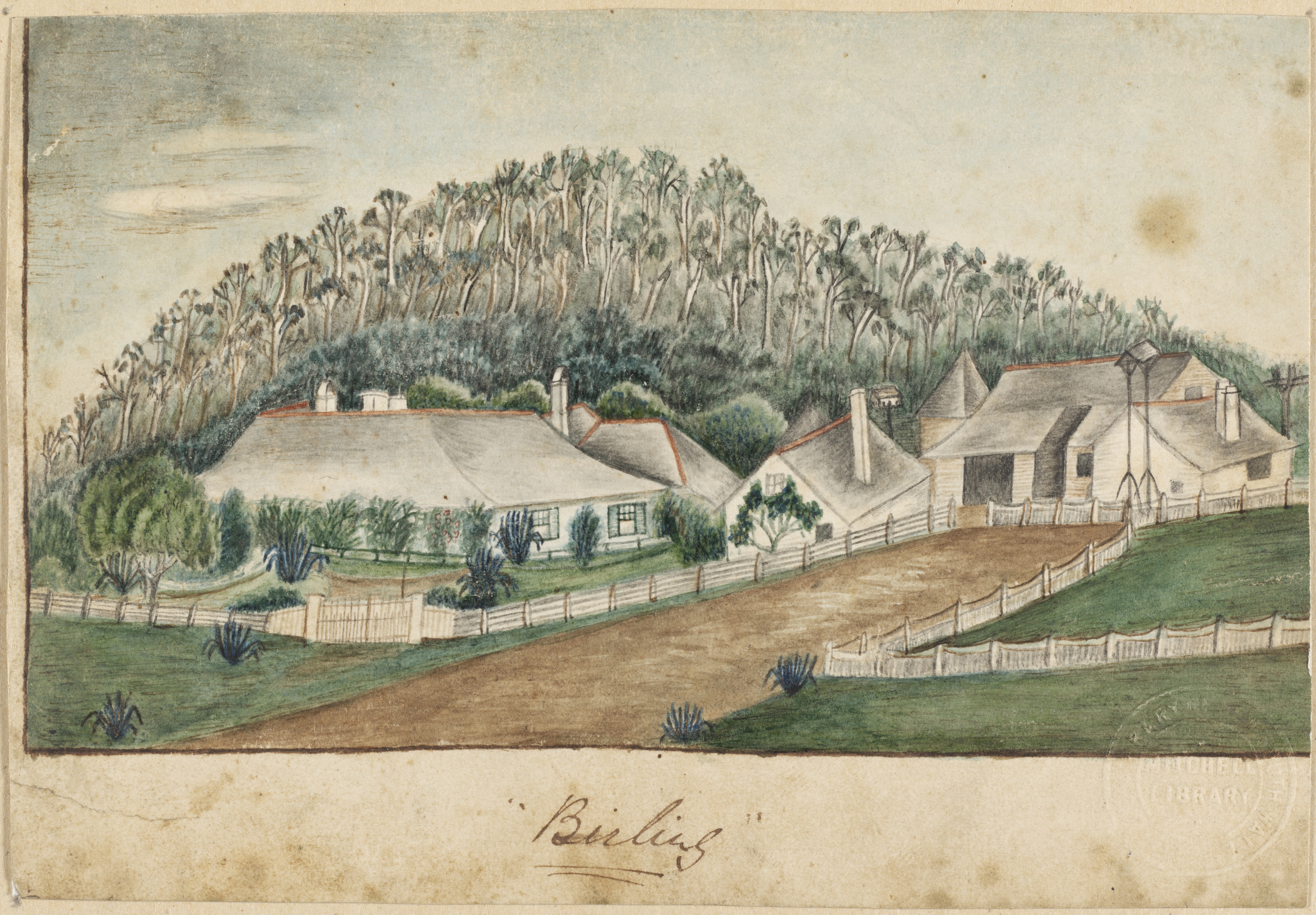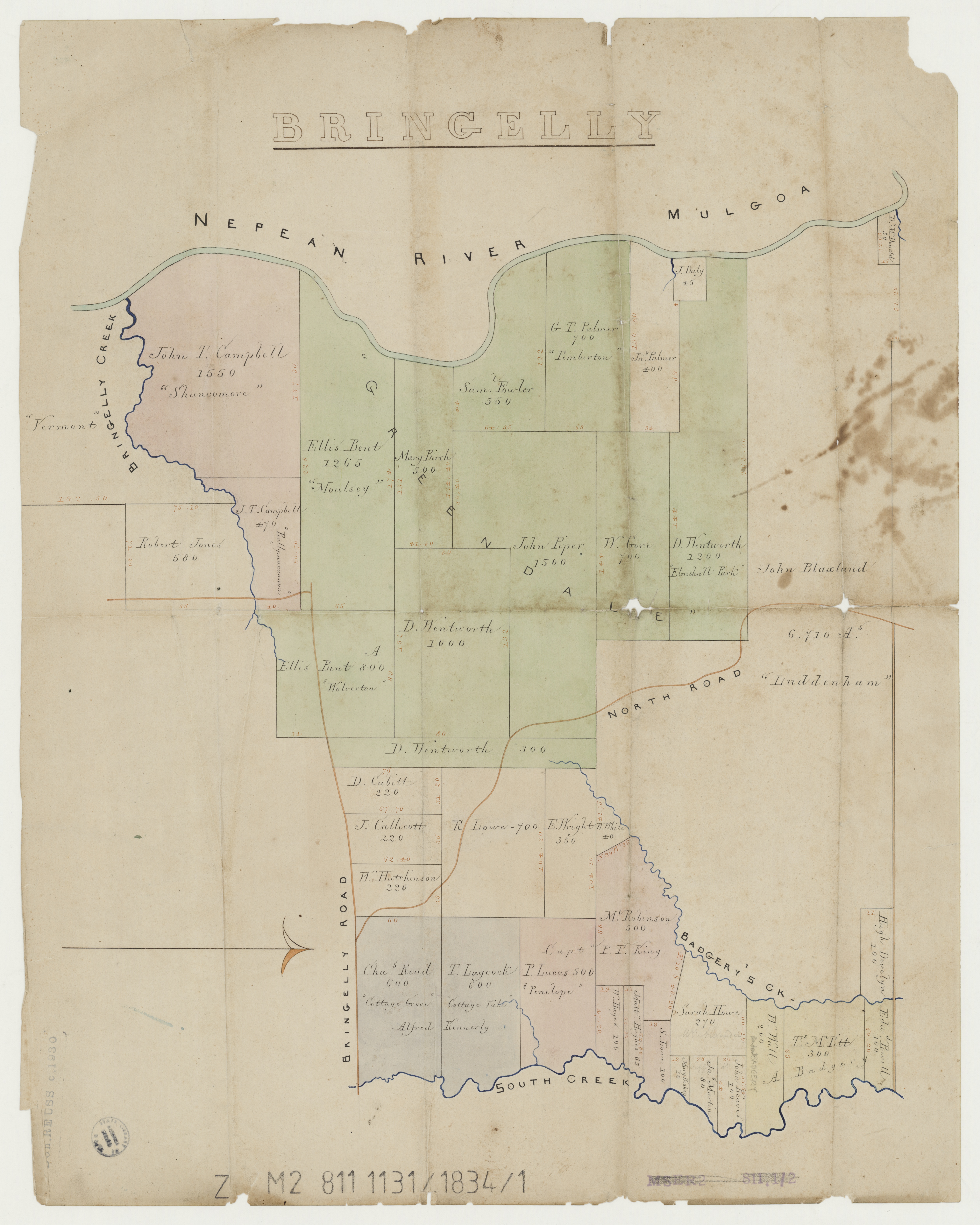Bringelly was officially gazetted on 7 April 1972 as part of the Parish of St Luke. Bringelly is shared between the Liverpool and Camden LGAs.
What’s in a Name?
The area was initially known to colonists as the Parish of Bringelly, but became officially called Bringelly when the Bringelly Post Office opened in 1857. The township was first formally named in 1863.
George Caley, a government botanist who explored the district in 1802, was the first to use Bringelly to name the area. However, some historians claim the name came from landholder Judge Advocate Ellis Bent, after a family estate in Wales.
Colonial Settlement
Bringelly is located on the Northern Road between Penrith and Camden. The earliest land grants in Bringelly were granted to Robert Lowe in 1812, who named his estate Birling Gap. Lowe later became Bringelly’s Magistrate. His court was located close to the intersection of Bringelly and Northern Road.
Many convicts arriving in Sydney where marched to Liverpool for labour assignments under Macquarie’s administration until the 1840s. To monitor their movements, Lowe regularly mustered convicts on Sundays in Bringelly. Convicts in assignment were not allowed to travel without a pass signed by the Magistrate and recorded by the Chief Constable of the district.
Early settlers in Bringelly included Judge Advocate Ellis Bent, Assistant Surgeon D'Arcy Wentworth and Superintendent of Convicts William Hutchinson. A former convict, Hutchinson was transported to Sydney with a sentence of seven years as punishment for theft. He later became the Superintendent for Convicts on Norfolk Island.

Birling, 1843 / Anne Dadswell. Image courtesy of the State Library of New South Wales (SSV1B/Brin/1).
Kelvin Park
Kelvin Park, a colonial Georgian single-storey homestead, formerly known as Cottage-ville or Retreat Farm, was originally owned by Thomas Laycock Junior. The house is located above Thompson’s Creek and is surrounded by landscaped gardens.
Laycock Jnr came to Australia as a child in 1789 with his family. He served in the New South Wales Corps and married Isabella Bunker, daughter of Liverpool colonialist Eber Bunker of Collingwood. The young couple left the colony for England in 1810, returning in 1817, not long after which Isabella passed away. Thomas Laycock remarried, and in 1818 received a grant of 240 hectares, which he named Cottage Vale. He purchased an additional 200 hectares and built a homestead and outbuildings around 1820. Thomas Laycock passed away at his estate in 1823.
The property was purchased by J.T. Campbell, who renamed it The Retreat. After his death in the 1830’s, the property was purchased by Alfred Kennerly who again renamed it to Kelvin. Kennerly later became the Premier of Tasmania. The Victorian brick coach house was built in the 1850s by Kennerley.
The property was later owned by the Australian Agricultural Company, the country’s oldest agricultural and pastoral development company, established in 1824.
The property still stands off Bringelly Road, known today as Kelvin Park. The colonial Georgian and early Victorian buildings are evidence that the land has been used for European farming for 187 years. The early tree plantings and remaining details of driveways, fencing and entrances contribute to the property’s historic value.

Map of Bringelly, 1834. Image courtesy of the State Library of New South Wales.
Bushrangers in Bringelly
The Bringelly area was notorious for its bushrangers. John (Jack) Donohoe, about whom the song The Wild Colonial Boy is believed to have been written, is said to have had several hideouts in the Bringelly area. He was shot dead by soldiers on an estate in Bringelly in 1830.
Donohoe (1806?-1830), was born in Dublin and convicted on 3 April 1823 of 'intent to commit a felony'. Sentenced to transportation for life, he reached Sydney Cove on 2 January 1825 in the Ann and Amelia. In the official notices Donohoe was described as '22 years of age, 5 feet 4 inches (163 cm) in height, brown freckled complexion, flaxen hair, blue eyes, and has a scar under the left nostril'. In the late afternoon of 1 September 1830, a detachment of soldiers and police came upon the gang in the Bringelly scrub near Campbelltown. During the ensuing fight Donohoe urged the police to 'come on, using the most insulting and indecent epithets'. He was killed by a ball fired by Trooper Muggleston.
“There was a wild colonial youth, Jack Doolan was his name
Of poor but honest parents, he was born in Castlemaine
He was his father's only hope, his mother's only joy
The pride of both his parents was the wild colonial boy…
In sixty-one this daring youth commenced his wild career
With a heart that knew no danger, no foeman did he fear
He held up the Beechworth mail coach and he robbed Judge MacEvoy
Who trembled and gave up his gold to the wild colonial boy…
He drew a pistol from his belt and spun it like a toy
"I'll fight, but I won't surrender, " said the wild colonial boy
He fired at trooper Kelly and brought him to the ground
And in return from Davis received a mortal wound
All shattered through the jaws, he lay still firing at Fitzroy
And that's the way they captured him, the wild colonial boy” – Excerpt from The Wild Colonial Boy, Anonymous, circa 1880.
The Sydney Gazette reported that Donohoe’s death occurred “at the estate of Mr. Wentworth”. D’Arcy Wentworth had purchased part of Birling Gap from Lowe in 1817. Wentworth owned a 400-hectare property in the Bringelly area and was a surgeon in the colony who later went on to become the Superintendent of Police.
Bringelly Public School
Bringelly Public School was opened in 1878. It was opened to replace the Church of England School in Cabramatta which closed in 1877. Bringelly Public School’s building, and 10 acres of land, were purchased by the Council of Education from George Strathfield. Strathfield’s house was converted into the school building with a large school room and accommodation for a married teacher. The school established a garden on the grounds and students would graze their horses during the day. By 1897, the building was in ill-repair and a new building was established. Enrolments were no higher than 60 pupils are year until 1962, when the area experienced rapid growth. By 1977, there were 168 students enrolled.
In 2023, part of the school grounds, which is fenced off from the main playing area, is protected under the Federal Heritage and Environmental Act. The area includes a school dam, school garden, wetland, and Cumberland Plains woodland. The classroom built in 1897 and original schoolhouse remain.
Bringelly Fire Brigade
Bringelly Bush Fire Brigade was established in 1939. By 1949, the brigade had 31 members. They had a small power pump and hose, six leather beaters, and two fire rakes. In 1972, the Brigade moved from a shed on Leo McRae’s property to Greendale Road (behind the Public School).
Changing Borders
Bringelly was originally part of Nepean Shire Council (formed in 1906). Nepean Shire Council covered the areas of Cobbitty, Hoxton Park, Austral, parts of Luddenham, and Narellan until December 1948, when the council was dissolved. The area was divided between Liverpool, Penrith, and Camden Councils. Electricity supplied by Liverpool Council came to Bringelly in 1937.
Aboriginal words of Australia [compiled by] A.W. Reed ; illustrated by E.H. Papps,196 FH 499.15 ABOR
Lachlan and Elizabeth Macquarie Archive (LEMA), (2011). Accessed 16 March 2022. https://www.mq.edu.au/macquarie-archive/lema/
Dictionary of Sydney, https://dictionaryofsydney.org/place/bringelly
Russel Ward. “Donohoe, John (Jack) (1806–1830).” In Australian Dictionary of Biography. Canberra: National Centre of Biography, Australian National University. Accessed March 16, 2022. https://adb.anu.edu.au/biography/donohoe-john-jack-1985
Sydney Gazette and New South Wales Advertiser. “ADVANCE AUSTRALIA Sydney Gazette.” September 7, 1830. http://nla.gov.au/nla.news-article2195973
“OUR HERITAGE: Exploring the history behind Macarthur's suburb names”, Camden-Narellan Advertiser, 23 September 2015. Access: https://www.camdenadvertiser.com.au/story/3372438/our-heritage-exploring-the-history-behind-macarthurs-suburb-names/
Camden Historical Society, Camden Council Library Service and Camden Council Community Profile
GEOGRAPHICAL NAMES ACT, 1966 (1972, April 7). Government Gazette of the State of New South Wales (Sydney, NSW : 1901 - 2001), p. 1199. Retrieved May 25, 2021, from http://nla.gov.au/nla.news-article220139777
Prospect Trust, A Tour of History in Bringelly and Cobbity (Blacktown: Prospect Trust), 1985. Catalogue record: https://liverpool.spydus.com/cgi-bin/spydus.exe/ENQ/WPAC/BIBENQ?SETLVL=&BRN=124415
Compiled by Liverpool City Library, Suburbs and Localities: Bringelly, Local Studies Pamphlet. Catalogue record: https://liverpool.spydus.com/cgi-bin/spydus.exe/ENQ/WPAC/BIBENQ?SETLVL=&BRN=74457
Compiled by Liverpool City Library, Streets and Roads: Bringelly Road, Local Studies Pamphlet. Catalogue record: https://liverpool.spydus.com/cgi-bin/spydus.exe/ENQ/WPAC/BIBENQ?SETLVL=&BRN=46648
See something missing?
You know your suburb better than anyone. If you think an important part of your suburb’s history is missing, whether recent or distant, reach out to the Local Studies Team through our online Local and Family History enquiry form. We are always looking for new ways to bring the vibrant history of Liverpool to life!
